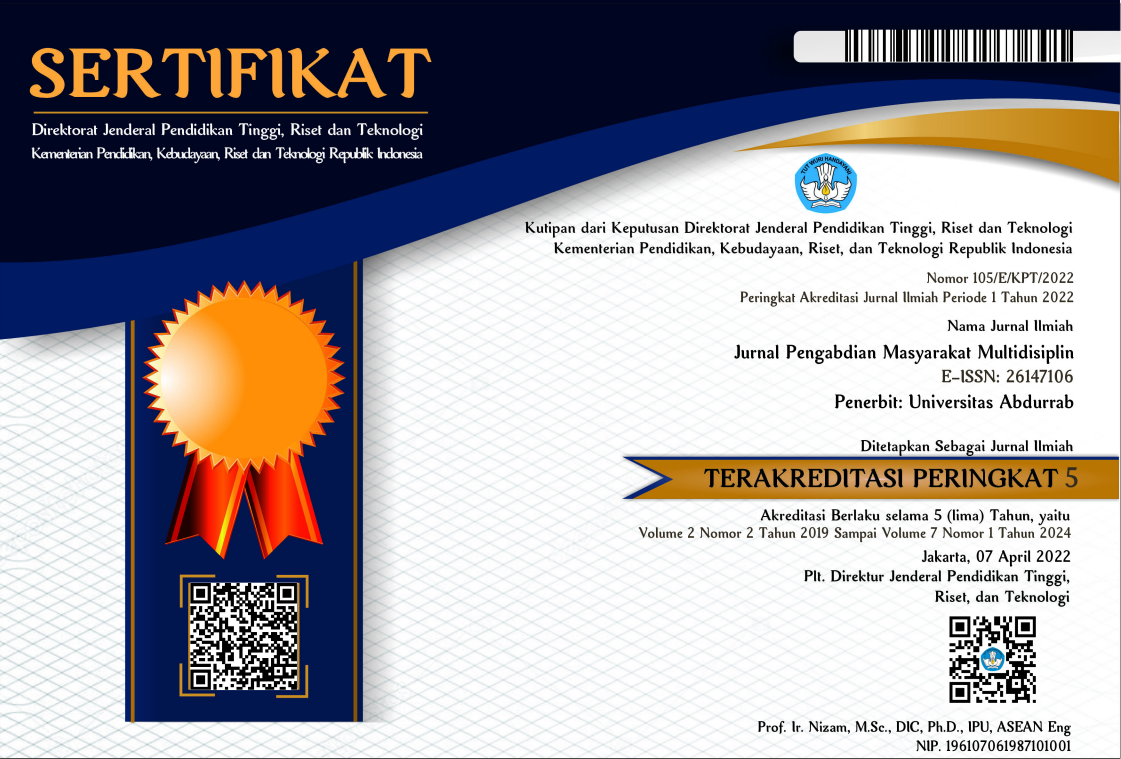EDUKASI ILMU GEOGRAFI TERAPAN: BIOGEOGRAFI PADA MURID XII IPS SMA IT NUR HIDAYAH
APPLIED GEOGRAPHY SCIENCE EDUCATION: BIOGEOGRAPHY FOR XII IPS STUDENTS OF SMA IT NUR HIDAYAH
Abstract
Biogeography is a branch of applied geography that studies about distribution of living organisms and their ecosystems in a biological community in a geographic area. Biogeography has an important role because it is connected to biological, agricultural and forestry sciences, such as understanding the evolutionary of organisms from geographic point of view, biodiversity conservation, environmental engineering and its application in the fields of agriculture and forestry. Geography is part of the social sciences. However, the subjects of social science taught in the Indonesian school curriculum are not comprehensive. In fact, the social science subject of geography is integrated with the concepts of social sciences, humanity, natural sciences, and even a combination of various issues. Thus, there is a possibility of a lack of competencies needed for students to advanced their studies. This activity was carried out through a offline seminar at SMA IT Nur Hidayah. The participants were students of class XII IPS total 83 students. As 96% of students were satisfied and responded well to this activity because they obtained new information that was not available during teaching and learning activities in high school in general. A total of 85% percent of students expressed the importance of study material.
References
Handoyo, B. and Soekamto H. “Perencanaan Pembelajaran Geografi (dilengkapi kurikulum merdeka)”. CV. Bayfa Cendekia Indonesia, Madiun, 2023.
Herbertson, A.J. Report on The Teaching of Applied Geography. Unpublished Report to the Council of The Manchester Geographical Society, 1899.
Palm, R. and Brazel, A. “Applications of Geographic Concepts and Methods”. In Abler, R., Marcus, M., Olsson, J. (Eds.). Geographies inner worlds, pp. 342-362. Rutgers University Press, New Brunswick, 1992.
Faour, G., Fayad, A., and Mhawej, M. “GIS-Based Approach to The Assessment of Coastal Vulnerability to Sea Level Rise: Case Study on The Eastern Mediterranean”. Journal of Surveying and Mapping Engineering vol. 1 no.3, pp. 41-48, 2013.
Kamranzad, F., Memarian, H., and Zare, M. “Earthquake Risk Assessment for Tehran, Iran”. ISPRS Int. J. Geo-Inf. Vol. 9 no. 7, pp. 1-19, 2020 . Doi:org/10.3390/ijgi9070430.
Liu, H., Zou, L., Xia, J., Chen, T., and Wang, F. “Impact Assessment of Climate Change and Urbanization on The Nonstationarity of Extreme Precipitation: A Case Study in An Urban Agglomeration in The Middle Reaches of The Yangtze River”. Sustainable Cities and Society vol. 85 no. 104038, 2022. Doi:org/10.1016/j.scs.2022.104038.
Waseem, M., Iqbal, F., Humayun, M., Umais, L. M., Javed, T., and Kebede L. M. “Spatial Assessment of Soil Erosion Risk Using RUSLE Embedded in GIS Environment: A Case Study of Jhelum River Watershed”. Appl. Sci. Vol. 13 no. 6, pp. 1-16, 2023. Doi:org/10.3390/app13063775.
Gülçin, D. and Akpınar, A. “Mapping Urban Green Spaces Based on An Object-Oriented Approach”. Bilge International Journal of Sciences and Technology Research vol. 2, pp. 71-81, 2018. Doi: 10.30516/bilgesci.486893.
Buscemi, J., O’Donnell, A., Takgbajouah, M., and Patano, P. “A Spatial Analysis of Food Insecurity and Body Mass Index with Income and Grocery Store Density in A Diverse Sample of Adolescents and Young Adults”. Nutrients vol. 15 no.6, pp. 1-10, 2023. Doi:org/10.3390/nu15061435.
Van de Vuurst, P. and Escobar, L.E. “Climate Change and Infectious Disease: A Review of Evidence and Research Trends”. Infect Dis Poverty vol. 12 no. 51, pp. 1-10, 2023. Doi:org/10.1186/s40249-023-01102-2.
Sumaatmadja, N. “Metodologi Pengajaran Geografi”. Bumi aksara, Jakarta, 1996.
Morrone, J.J. “The Spectre of Biogeographical Regionalization”. Journal of Biogeography vol. 45 no. 2, pp. 282-288, 2018. Doi:org/10.1111/jbi.13135.
Mutiani, M., Supriatna, N., Abbas, E.W., Rini, T.P.W., and Subiyakto, B. “Technological, Pedagogical, Content Knowledge (TPACK): A Discursion in Learning Innovation on Social Studies”. The Innovation of Social Studies Journal vol. 2 no. 2, pp. 135-142, 2021. Doi:10.20527/iis.v2i2.3073.
Rahmatina, Subiyakto, B., and Rahman, A.M. “Contribution of Geography Concepts in The Content of Junior High School Social Studies Subjects”. The Kalimantan Social Studies Journal vol. 2 no. 2, pp. 170-180, 2021. Doi:org/10.20527.
Musdalipah, Subiyakto, B., and Rahman, A.M. “Contribution of Geography in Social Studies Education to Inculcate Environmental Awareness”. The Kalimantan Social Studies Journal vol. 2 no. 2, pp. 141-148, 2021. Doi:org/10.20527.
Copyright (c) 2024 Jurnal Pengabdian Masyarakat Multidisiplin

This work is licensed under a Creative Commons Attribution-NonCommercial-ShareAlike 4.0 International License.
1. Copyright of all journal manuscripts is held by the Jurnal Pengabdian Masyarakat Multidisiplin.Formal legal provisions to access digital articles of electronic journal are subject to the provision of the Creative
2. Commons Attribution-ShareAlike license (CC BY-NC-SA), which means that Jurnal Pengabdian Masyarakat Multidisiplin is rightful to keep, transfer media/format, manage in the form of databases, maintain, and
3. publish articles.Published manuscripts both printed and electronic are open access for educational, research, and library purposes. Additionally, the editorial board is not responsible for any violations of copyright law.
licensed under a Creative Commons Attribution-ShareAlike 4.0 International License.
 PDF (Bahasa Indonesia)
PDF (Bahasa Indonesia)
 Abstract views: 62
Abstract views: 62
 downloads: 36
downloads: 36

 :
:




